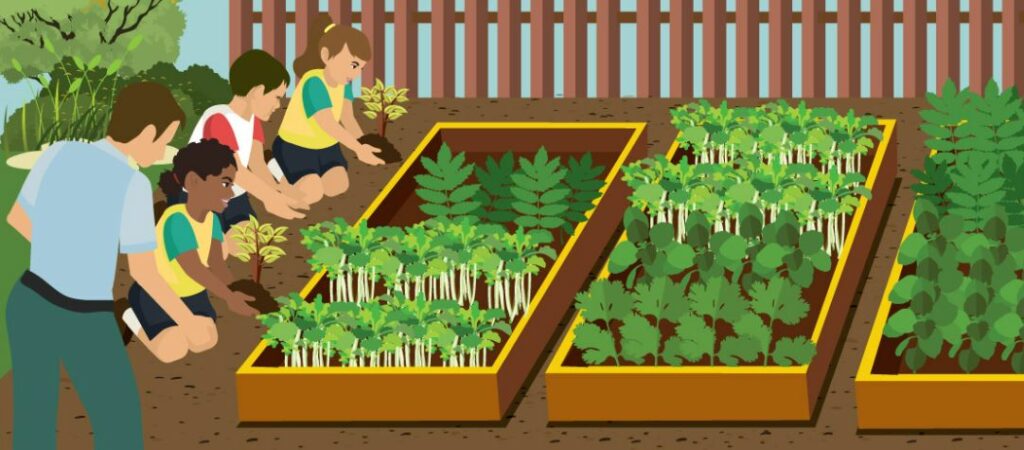Stay in Touch
Stay up to date with the latest news from Fertile GroundWorks.
(Your data is safe. We’d never share it with any third parties.)
The garden will be growing without us starting December 22nd, and we will be back on January 7th.
Our sincere wishes that your holidays are full of joy and good eats.
Thank you for all your help in 2024 and we look forward to seeing you all in 2025!


Just as you’re able to get into the dirt and start planting your spring crops, little hands across the tri-valley are, too! Fertile GroundWorks supports 23 local schools and 4 community gardens by providing supplies, materials, and seedlings necessary for starting up the garden and learning along the way.
Inspiring our youth and the next generation of gardeners and environmental stewards is an invaluable part of our mission to “Teach” as we Teach. Grow. Give.
How many of you are planting something new for the first time? How about learning a few new tricks each season through trial and error? Do you find inner peace just being outdoors and letting nature be your teacher? Imagine enjoying all that from a young age, being part of the growing process beginning to end, and ultimately enjoying the food that nourishes you and your family! That’s what we hope to do for our kids.
There’s no better time to start! Ask your schools about starting up a school garden. Happy Planting!
Hey there, how ya Bean?
Beans enrich your soil with nitrogen fixation and provide you with loads of vitamins! While the plants love warm and full sun, they will cease to set fruit when temperatures exceed 90F. Plant seeds about 2-4 inches apart with wide rows (12-14 inches apart). Pick regularly. If you intend to harvest beans for winter casseroles and meals, let beans mature on the vine before picking them.
Oh, these little Cute-Cumbers!
Cucumbers do well on trellises, saving space and making harvesting easier. Cukes have tendrils and will generally climb well on their own, may need some initial encouragement. Plant 4-6 inches apart. Once fruit bearing begins, pick daily. Older fruits will become rubbery and hollow.
Egg-ceptionally delicious!
Eggplants are compact upright plants that need to be about 18” apart. If grown in shady conditions, plants get leggy and may benefit from caging or staking. Pick fruits regularly to encourage production.
Green machine
Greens are a great source of vitamins and are a yummy year-round crop here in Livermore. Harvest greens by taking lower leaf stalks as you need them. Leave a couple lower leaves for photosynthesis and the apical (growing tip) leaves to make your harvest year-round.
Sweet, Humble, Grounded
Fertile GroundWorks tried these in 2020 and they grew to be a favorite volunteer treat! They are fun to eat and are pretty much as close to candy as you can get with something grown from the ground.
**The unripe green fruit and leaves are very high in solanine and other solanidine alkaloids, these are considered TOXIC so do NOT eat unripe fruit wait for them to turn yellow and/or hit the ground.
Kind of a big Dill
The oregano, rosemary and thyme are perennial plants in our lovely Mediterranean climate so you can plant them as a permanent part of your landscape. The basils, parsley and cilantro are annuals here but will self-seed in your herb garden.
Romain calm! Your plants will thrive!
Lettuce will bolt when Summer comes so enjoy them while you can! You can save the seeds for an early Fall crop.
You’re one in a Melon!
Melon vines can take a goodly amount of garden space. The vines are okay on trellises, but you need to support the fruits. Days to maturity are from transplanting.
Sweet or spicy, get a Pep in your step!
Peppers are compact upright plants that need to be about 14-18” apart and love warmth and full sun. Caging isn’t necessary, but staking could help provide support. Plants in shady areas become leggier and require more support. Larger sweet peppers often suffer from sunscald, so shade the fruit if possible. Peppers may be eaten in the green stage, but ripening to yellow or red increases the flavor and nearly doubles the Vitamin C content.
Oh my Gourd, my favorite!
Summer squashes like zucchinis typically grow in bush form. Space 18-24” apart. Winter squash is a vining plant that can spread. Space 24-36” apart. Yellow fruits are due to poor pollination. You can initiate pollination by taking male flowers and mixing pollen with female flowers. Summer squash must be harvested regularly. It doesn’t store well, so eat immediately.
Love you from my head Tomatoes!
Tomatoes love warmth and full sun. Determinate varieties tend to be more compact, need less staking and have a shorter, more concentrated fruiting season than indeterminate varieties. Prune leaves to yield more fruit. Keep enough leaves to protect the plant from sunscald.
Stay up to date with the latest news from Fertile GroundWorks.
(Your data is safe. We’d never share it with any third parties.)
© 2024 Fertile GroundWorks